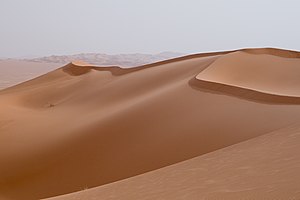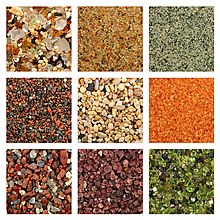Term: Sand
**Composition and Definition:**
– Sand grains are smaller than gravel and coarser than silt.
– Sand contains silica (silicon dioxide) as the most common constituent.
– Sand may also be composed of calcium carbonate or calcium sulfate.
– Sand is a non-renewable resource over human timescales.
– Desert sand is not suitable for making concrete.
– Unified Soil Classification System defines sand as particles with a diameter between 0.074 and 4.75 millimeters.
– Geologists classify sand particles with diameters ranging from 0.0625mm to 2mm.
– Sand falls between gravel and silt in terms of particle size.
– Sand can be categorized as fine, medium, and coarse based on size.
– Sand feels gritty when rubbed between fingers, unlike silt which feels like flour.
**Mineral Composition and Sources:**
– Silica (SiO2) in the form of quartz is the most common mineral in sand.
– Sand composition varies based on local rock sources and conditions.
– Bright white sands in tropical areas are eroded limestone with coral and shell fragments.
– Some sands contain magnetite, chlorite, glauconite, or gypsum.
– Sand deposits in certain areas contain garnets and small gemstones.
– Sand is formed from the weathering of rocks mainly by water and wind erosion.
– Sand from rivers and flood plains is the primary source for construction.
– Sand dunes are formed in dry conditions or by wind deposition.
– The Sahara Desert has vast sand dunes due to lack of vegetation and water.
– Beach sand is formed by erosion, weathering, river deposition, and marine interactions.
**Uses and Demand:**
– Sand is used in high demand for making concrete.
– Beach sand and fossil sand are extensively used for construction.
– Desert sand is not suitable for concrete due to its properties.
– Sand mining in rivers causes environmental concerns and economic losses.
– Wind shapes desert sand to be round and smooth, making it unusable for construction.
– Sand as an abrasive element.
– Sandy soils are ideal for certain crops.
– Sand used in air filtration and aquaria.
– Sand essential in concrete, glass, and mortar.
– Sand employed in landscaping, roads, and recreation.
**Resources, Environmental Concerns, and Hazards:**
– Some sands not suitable for construction.
– Demand for construction sand depleting natural sources.
– Impact of sand mining on marine life and ecosystems.
– Environmental concerns over dredging industry.
– Countries banning sand exports due to environmental issues.
– Silica sand used in sandblasting poses health risks.
– Respiratory protection recommended for sandblasting.
– Excessive inhalation of crystalline silica is a health concern.
– Safety data sheets warn of health risks from silica dust.
– Precautions necessary for sand-using activities such as sandblasting.
**Manufacture and Case Studies:**
– Manufactured sand (M sand) is made from rock through artificial processes for construction purposes in cement or concrete.
– M sand is more angular compared to river sand and possesses slightly different properties.
– Dubai, UAE has high demand for sand in infrastructure and island construction, leading to the use of over 835 million tonnes of sand in projects costing more than US$26 billion.
– Sand reserves in Dubai were depleted, necessitating the import of sand from Australia for construction projects.
Sand is a granular material composed of finely divided mineral particles. Sand has various compositions but is defined by its grain size. Sand grains are smaller than gravel and coarser than silt. Sand can also refer to a textural class of soil or soil type; i.e., a soil containing more than 85 percent sand-sized particles by mass.


glass, dune, quartz,
volcanic, biogenic coral, pink coral,
volcanic, garnet, olivine.
Samples are from the Gobi Desert, Estonia, Hawaii and the mainland United States. (1×1 cm each)
The composition of sand varies, depending on the local rock sources and conditions, but the most common constituent of sand in inland continental settings and non-tropical coastal settings is silica (silicon dioxide, or SiO2), usually in the form of quartz.
Calcium carbonate is the second most common type of sand, for example, aragonite, which has mostly been created, over the past 500 million years, by various forms of life, like coral and shellfish. For example, it is the primary form of sand apparent in areas where reefs have dominated the ecosystem for millions of years, as in the Caribbean. Somewhat more rarely, sand may be composed of calcium sulfate, such as gypsum and selenite, as is found in places such as White Sands National Park and Salt Plains National Wildlife Refuge in the U.S.
Sand is a non-renewable resource over human timescales, and sand suitable for making concrete is in high demand. Desert sand, although plentiful, is not suitable for concrete. Fifty billion tons of beach sand and fossil sand are used each year for construction.
